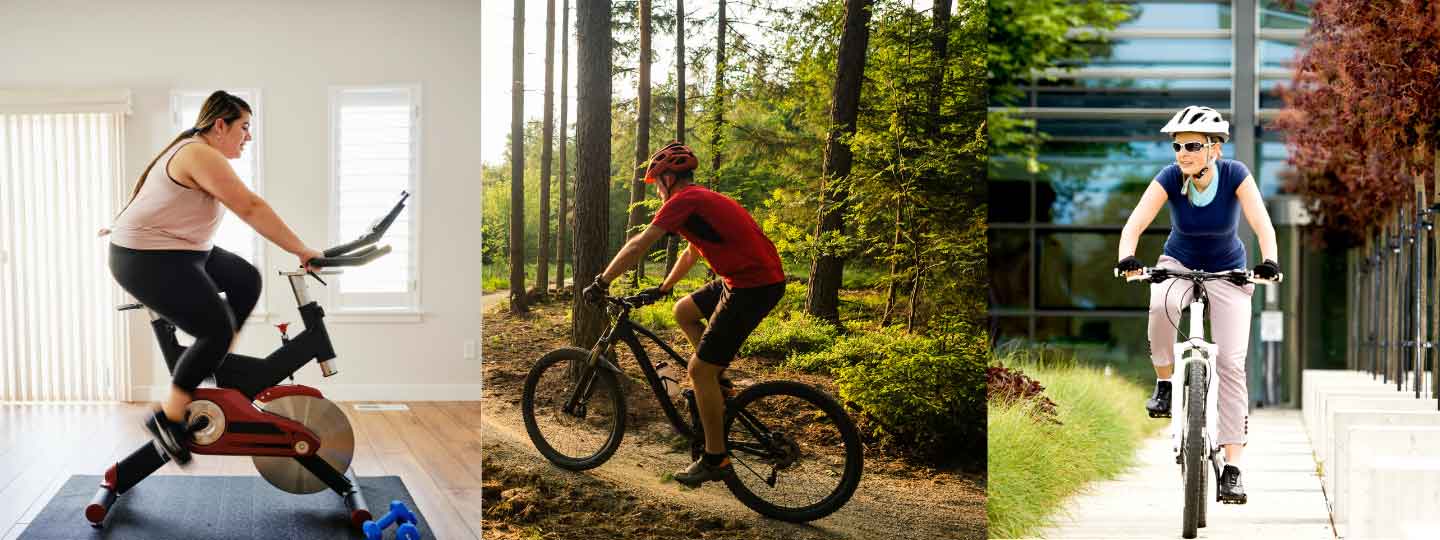Cycling - top tips for getting into gear
12 July 2022
Whether you’re new to cycling or an experienced cyclist, it’s important to be prepared. This includes finding a routine and pace which fits with your life and the best bike for your needs.
Cycling is a fantastic activity, especially if you have arthritis, particularly knee osteoarthritis, as it places very little stress on your joints. It can be done outdoors, at a gym or at home.
As a low-impact form of exercise, it can be beneficial in improving the range of movement without putting too much stress on the joints. Cycling is also great for building stronger muscles and it can be a great way of improving cardiovascular health
You might decide to invest in an electric bike as they offer battery pedal-assist or perhaps a recumbent bike would be better for you, as you are not sitting upright whilst exercising. This takes weight off the wrist and knee joints and can be helpful if you find gripping with your hands difficult. It can also be a safer option, if you have issues with balance.
Learn more about exercise and the ways you can keep your joints healthy.
Strengthening your muscles
Cycling encourages motion in the knees and hips, and it can strengthen your quadricep muscles (on the front of your thighs).
Pedalling also works your glutes and hamstrings (on the back of your thigh). By doing muscle strengthening exercises regularly, you will be helping to support and protect your joints.
Find a pace that works for you
You can enjoy a gentle bike ride or work at a higher intensity. You know your body and what feels right for you. Listen to your body and if anything feels too painful, take a rest or stop.
Increase your time on the bike gradually to build up your strength, and this will minimise the chance of injury.
The key is to make movement part of your daily routine, as this will improve wellbeing and your fitness. Also, it can help boost your circulation and ease pain and stiffness.
If you have any concerns about whether you should exercise, read our ask the expert Q&A with Dr Benjamin Ellis.
Get the right equipment
You can buy a new or second-hand bike and your local bike shop will be able to offer good advice on the correct bike to suit your needs. They’ll also be able to give advice on whether other equipment might help you, such as padded gloves to support your wrists. Plus, they can check the bike is set up correctly for you, for example, the position of the seat.
It’s also extremely important to wear a well-fitting helmet if you are cycling outside. Most cycling shops will sell suitable helmets and it’s a good idea to make sure they’ve been approved by the National Standard for Cycling.
Warm up and cool down
You should include a simple warm up, stretch and cool down routine as part of your cycling routine.
Combining cycling with stretching and strengthening exercises will also help to increase flexibility and ease stiffness.
Easing any aches
If you feel achey, you may find it helpful to have a bath with Epsom salts to soothe your legs. Many people find heat pads, hot water bottles and / or ice packs help to ease aches and pain.
Learn more about painkillers and complementary and alternative treatments.
Other ways to keep moving
Sharing experiences of your physical activity journey can be a brilliant motivator. If you're on Facebook why not join our Let's Move group?
Check out the We Are Undefeatable website. They have exercise ideas ranging from yoga to dancing in your kitchen.
We’re here whenever you need us
- If you need advice or support, you can call our free helpline on 0800 5200 520
- Chat to our Arthritis Virtual Assistant
- Join our online community
- Stay in touch and follow us on Twitter, Facebook and Instagram.
You might also be interested in...
-
6 steps to better mornings
We asked Dr Haseler and rheumatology occupational therapist Angela Jacklin for their advice on getting your day off to the best possible start.
-
How to stay motivated to exercise?
To help you, here’s Leon's advice on ways to find what works for you and tips to keep motivated.